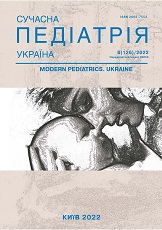Prediction of the course of hypoandrogenism in adolescent boys
DOI:
https://doi.org/10.15574/SP.2022.126.37Keywords:
hypoandrogenism, sexual development, adolescent boys, prognosis of the course of the diseaseAbstract
The most pathological conditions that adversely affect the reproductive function in men of mature age is formed precisely in adolescence as a result from hypoandrogenism (HA), - a decrease in the production of male sex hormones (androgens) below the age norm. Therefore, the ability to predict the course of HA in adolescent boys allows to prevent serious health problems in the future.
Purpose - to determine significant prognostic criteria for adverse course of HA in adolescent boys with delayed sexual development.
Materials and methods. Were examined 157 boys 14-17 years old with signs of androgen deficiency, the degree of which was based on the assessment of total testosterone (TT). The levels of gonadotropic hormones, estradiol, their ratios were studied by enzyme-linked immunosorbent assay, and the content of thyroid-stimulating hormone and free thyroxine, their ratio was determined. The lipid spectrum of blood was studied. On the basis of X-rays of the non-dominant hand and wrist determined bone age and ossification deficiency. Сonditionally unfavorable course of HA was formed in adolescent boys with severe androgen deficiency (HA 3 degree) at the level of total testosterone <4 nmol/l. Favorable course of HA was considered to be the presence of clinical signs of hypoandrogenism in adolescents with normal TT, levels more than 12 nmol/l (HA 0 degree).
Results. Based on the study was identified the most informative features and calculated their prognostic coefficient. It is proved that significant informative signs of HA in adolescent boys are such as body mass index abnormalities, bone age deficit, levels and ratios of gonadotropic hormones, estradiol values and testosterone / estradiol, testosterone / luteinizing hormone ratios, thyroid stimulating hormone / free thyroxine, changes in lipid profile. To the most prognostically significant negative prognostic criteria for adverse HA in adolescent boys are excess body weight by body mass index level, significant deficit of bone age (more than 3 years), decreased luteinizing hormone levels, decreased luteinizing hormone / follicle stimulating hormone ratio, hyperestrogenism, pronounced androgenic-estrogenic disbalance, the presence of minimal thyroid dysfunction, disorders of the lipid profile.
Conclusions. The developed prognostic criteria for adolescent boys with HA will make it possible to predict the further course of the disease (in the early stages of its formation pathology), what will carry out timely treatment and rehabilitation measures in adolescent boys, and this will help to improve their health. Teens with HA, who show prognostically unfavorable signs, need more careful dispensary observation of an endocrinologist.
The research was carried out in accordance with the principles of the Helsinki Declaration. The study protocol was approved by the Local Ethics Committee of all participating institutions. The informed consent of the patient was obtained for conducting the studies.
No conflict of interests was declared by the authors.
References
Bagackaya NV. (2021). Analiz rodoslovnyh v semyah malchikov-podrostkov s zaderzhkoj polovogo razvitiya. Bioscience Publisher, Chicago, USA: 156-165.
Gubler EV. (1990). Informatika v patologii, klinicheskoj medicine i pediatrii. L.: Medicina: 176.
Halpern A et al. (2010). Metabolic syndrome, dyslipidemia, hypertension and type 2 diabetes in youth: from diagnosis to treatment. Diabetol. Metab. Syndr. 2: 55-75. https://doi.org/10.1186/1758-5996-2-55; PMid:20718958 PMCid:PMC2939537
Jolliffe CJ, Janssen I. (2007). Development of age-specific adolescent metabolic syndrome criteria that are linked to the Adult Treatment Panel III and International Diabetes Federation criteria. J. Am. Coll. Cardiol. 49 (8): 891-898. https://doi.org/10.1016/j.jacc.2006.08.065; PMid:17320748
Kosovtcova GV. (2003). Zatrimka statevogo rozvitku u hlopciv-pidlitkiv ta pidhodi do yih reabilitaciyi. Avtoref. dis. … kand. med. nauk: spec.14.01.14. Kyiv: 20.
Luchickij EV, Bondarenko VA. (2010). Izbrannye lekcii po klinicheskoj andrologii. Monografiya. Pod red. E.V. Luchickogo i V.A. Bondarenko. Kiev, Harkov: Izd-vo OOO firma «Nova Soft»: 144.
Luchickij YeV, Luchickij VYe. (2016). Porushennya statevogo dozrivannya. Klinichna endokrinologiya dityachogo ta pidlitkovogo viku. Pod red. M.D. Tronka i O.V. Bolshovoyi. K.: Zdorov'ya Ukrayini: 497-575.
Plehova EI, Hizhnyak OO, Levchuk LP, Bagackaya NV, Turchina SI. (2000). Zaderzhka polovogo razvitiya malchikov. Znanie-M: 112.
Plehova OI. (2014). Gipofunkciya statevih zaloz u hlopciv. Ukrayinskij zhurnal dityachoyi endokrinologiyi. 4: 5-12.
Spuzyak MI. (1999). Rentgenogramometriya v pediatrichnij rentgenologiyi. Strij: UKRPOL: 164.
Turchina SI. (2020). Kriteriyi viznachennya gipoandrogeniyi u hlopciv-pidlitkiv. Ukrayinskij zhurnal dityachoyi endokrinologiyi. 4 (36): 42-47.
Zelinskaya NB. (2009). Protokoli nadannya medichnoyi dopomogi dityam za specialnistyu "Dityacha endokrinologiya". Pid red NB Zelinskoyi. Kyiv: MOZ Ukrainy: 94.
Downloads
Published
Issue
Section
License
Copyright (c) 2022 Modern pediatrics. Ukraine

This work is licensed under a Creative Commons Attribution-NonCommercial 4.0 International License.
The policy of the Journal “MODERN PEDIATRICS. UKRAINE” is compatible with the vast majority of funders' of open access and self-archiving policies. The journal provides immediate open access route being convinced that everyone – not only scientists - can benefit from research results, and publishes articles exclusively under open access distribution, with a Creative Commons Attribution-Noncommercial 4.0 international license (СС BY-NC).
Authors transfer the copyright to the Journal “MODERN PEDIATRICS. UKRAINE” when the manuscript is accepted for publication. Authors declare that this manuscript has not been published nor is under simultaneous consideration for publication elsewhere. After publication, the articles become freely available on-line to the public.
Readers have the right to use, distribute, and reproduce articles in any medium, provided the articles and the journal are properly cited.
The use of published materials for commercial purposes is strongly prohibited.

